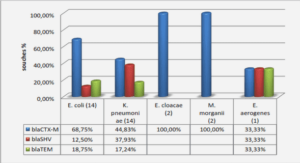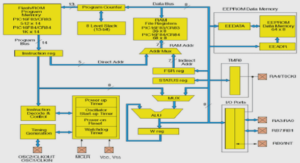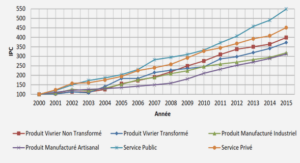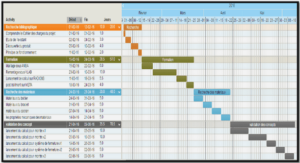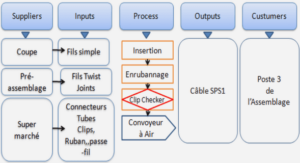Fate and biological activity of the antimicrobial lasso peptide microcin J25 under gastrointestinal tract conditions
Fate and biological activity of the antimicrobial lasso peptide microcin J25 under gastrointestinal tract conditions
Résumé
La microcine J25 (MccJ25) est une bactériocine qui possède une activité inhibitrice contre des bactéries pathogènes à Gram-négatif telles que Salmonella, Shigella, et Escherichia coli. Grâce à sa structure en lasso, ce peptide de 21 acides aminés est remarquablement stable en présence de la chaleur et à des valeurs extrêmes de pH et résistance à de nombreuses protéases. Dans cette étude, nous avons utilisé le simulateur dynamique in vitro du tube digestif TIM-1 afin d’évaluer la stabilité et l’activité antibactérienne de la MccJ25 lors de son passage dans la partie proximale du tractus gastro-intestinal humain. La concentration de la MccJ25 a été mesurée par HPLC dans les différents compartiments du TIM-1, et l’inhibition de Salmonella enterica serotype Enteritidis a été évaluée en utilisant les tests qualitatifs et quantitatifs de l’activité antibactérienne. Les analyses par LC-MS/MS ainsi qu’une analyse subséquente par l’approche des réseaux moléculaires utilisant la plateforme GNPS (Global Natural Product Social Molecular Networking) et l’analyse de la dégradation peptidique en présence d’enzymes protéolytiques mimant les conditions gastro-intestinales ont permis de déterminer le comportement de la MccJ25 par l’identification de ces principaux produits de dégradation. La MccJ25 s’est montrée relativement stable dans les conditions gastriques, mais se dégrade rapidement dans le compartiment duodénal, notamment en présence de la pancréatine. Parmi les composants de la pancréatine, l’élastase I est apparue principalement responsable de la dégradation de la MccJ25, alors que l’α-chymotrypsine était moins efficace.
Abstract
The bacteriocin microcin J25 (MccJ25) inhibits the growth of Gram-negative pathogens including Salmonella and Shigella species, and Escherichia coli. This 21-amino acid peptide has remarkable stability to heat and extreme pH values and resistance to many proteases, thanks to a characteristic lasso structure. In this study, we used the dynamic simulator TIM-1 as gastro-intestinal tract model to evaluate the stability and antibacterial activity of MccJ25 during passage through the proximal portion of the human gastrointestinal tract. MccJ25 concentration was measured in the different simulator sections by HPLC, and inhibition of Salmonella enterica serotype Enteritidis was evaluated using qualitative and quantitative assays. LC-MS/MS analysis and subsequent molecular networking analysis on the Global Natural Product Social Molecular Networking platform (GNPS) and analysis of the peptide degradation in the presence of proteolytic enzymes mimicking the gastro-intestinal conditions permitted to delineate the fate of MccJ25 through identification of the main degradation products. MccJ25 was relatively stable under gastric conditions, but degraded rapidly in the compartment mimicking the duodenum, notably in the presence of pancreatin. Among pancreatin components, elastase I appeared primarily responsible for MccJ25 breakdown, while α-chymotrypsin was less efficient.
Introduction
Antibiotics have been used for nearly a century in human and veterinary medicine and for therapeutic or growth-promoting purposes in livestock production (Gustafson and Bowen, 1997; Gyles, 2008). They remain the most widely used chemicals for treating infections. Their use in animal feed began to grow steadily in the early 1950s, when it was observed that keeping animals free of bacterial infections increased livestock productivity considerably and thus reduced production costs (Viola and DeVincent, 2006). However, overuse of antibiotics with structural features similar to those used in human medicine led to the emergence of pathogens with resistance to at least one antibiotic used to treat infections (Reardon, 2014). This worrying development led the European Union to declare a total ban on antibiotics as growth promoters in animal feeds since 2006 (Castanon, 2007a). The first industries affected by the ban were hog and poultry production, the principal users of antibiotics as feed additives. It is clear that a satisfactory alternative to antibiotics would be welcome in these industries. Among the alternatives being proposed are natural antimicrobial peptides produced by bacteria, essentially lactic acid bacteria, termed bacteriocins (Ennahar et al., 2000). The production of bacteriocins by bacterial strains is well documented in the literature (Hammami et al., 2013b). However, very few bacteriocins have been approved by regulatory agencies for use in food, medical or veterinary products, despite the increasing urgency of the demand for such compounds.
A bacteriocin is most often defined as a peptide of molecular mass mostly < 10,000 Da that is inhibitory to species closely related to the producer species. Bacteriocins differ from antibiotics in being synthesized by translation of an mRNA transcript, having generally a narrow spectrum of activity and being effective at concentrations as low as nanomolar (Nes, 2011). Some bacteriocins may undergo post-translational modifications and as such belong to the family of ribosomally-synthesized and post-translationally-modified peptides (RiPPs) (Arnison et al., 2013) Their potential as antimicrobials, especially in food matrices such as dairy, meat and plant products, has been evaluated repeatedly (Cleveland et al., 2001). However, few studies have focused on their potential as inhibitors of enteric pathogens in animals or humans. The stability of bacteriocins in the gastrointestinal tract is uncertain, and their resistance to acid, bile and gastric and pancreatic enzymes is a current research topic. In a previous study, we showed that the class IIa bacteriocin pediocin PA-1 was sensitive to gastrointestinal conditions, losing completely its antibacterial activity in the small intestine (Kheadr et al., 2010).
In this work, we examined the potential of microcin J25 (MccJ25), a well-studied bacteriocin produced by the Gram-negative species Escherichia coli and of high interest as a potential alternative to conventional antibiotics, because of its potent inhibitory activity against pathogens belonging to the genera Escherichia, Salmonella and Shigella (Salomon and Farías, 1992b; Sable et al., 2000; Rintoul et al., 2001b; Vincent and Morero, 2009). Interestingly its activity is maintained in complex matrices and in a mouse model of infection (Lopez et al., 2007a). MccJ25 is produced by Escherichia coli AY25 as a translated peptide precursor, which undergoes posttranslational modification ensured by two dedicated enzymes (Duquesne et al., 2007c; Yan et al., 2012). The process leads to the 21 amino-acid mature peptide (Figure 1), which encompasses an N-terminal macrolactam ring of 8 residues, through which the C-terminal tail threads and is tightly maintained by steric hindrance of two aromatic bulky side chains (Phe19 and Tyr20) (Bayro et al., 2003; Rosengren et al., 2003; Wilson et al., 2003). This confers to the peptide a unique [1]rotaxane topology known as the lasso structure. This peculiar highly rigid structure has been shown to confer to MccJ25 remarkable stability to high temperatures and extreme pHs (Salomon and Farías, 1992b; Blond et al., 2001b) and to make the molecule highly resistant to many proteases (Blond et al., 1999a; Rosengren et al., 2004). Such features are important if this bacteriocin is to be considered for use as a natural alternative to antibiotics. However, although its properties hold promise, there are no reports on its stability and inhibitory activity under the human GI tract conditions.
The goal of the present study was therefore to evaluate the stability and the inhibitory activity of MccJ25 against Salmonella enterica serotype Enteritidis in the upper portion of the human GI tract using a dynamic simulator (TIM-1), as gastrointestinal (GI) tract model.
Material & methods
Bacterial strains and growth conditions
MccJ25 was produced by a clone of E. coli MC4100 carrying a mutated pTUC202 plasmid that confers chloramphenicol resistance (Solbiati et al., 1999). S. enterica subsp. enterica ser. Enteritidis (Ducasse et al., 2012) was used as a sensitive strain for antibacterial activity assays. Both bacterial strains were obtained from Prof. Sylvie Rebuffat (Muséum national d’Histoire naturelle, MCAM laboratory, Paris, France). As described by (Ducasse et al., 2012), E. coli MC4100 harbouring the pTUC202 plasmid was cultured overnight at 37°C in Luria–Bertani (LB) broth (Difco, Sparks, MD, USA) supplemented with 34 mg/mL chloramphenicol under aerobic condition while S. enterica ser. Enteritidis was cultured overnight at 37°C in LB broth under aerobic condition.
2.4.2. Enzymes and chemicals
Pancreatin from porcine pancreas, pepsin from porcine gastric mucosa (EC 3.4.23.1), trypsin (EC 3.4.21.4), elastase type IIA from porcine pancreas (EC 3.4.21.36) and α-chymotrypsin from bovine pancreas (EC 3.4.21.1) were purchased from Sigma-Aldrich. Lipase from Rhizopus oryzae (EC 3.1.1.3) was from Amano Enzymes Inc. (Nagoya, Japan). All chemicals (HPLC solvents and salts for bacteriological media) used in the study were of high analytical grade.
2.4.3. Production and purification of MccJ25
Production and purification of MccJ25 was adapted from Blond et al. (Blond et al., 1999a; Rebuffat et al., 2004). Briefly, 3 L of minimal medium (M63) containing KH2PO4 (3 g/L), K2HPO4 (7 g/L), (NH4)2HPO4 (2 g/L) and casamino acids (1 g/L) were supplemented after autoclaving with MgSO4 1 mL/L, glucose 10 mL/L and thiamine 1 mL/L, added as 0.2 µm-filtered solutions (respectively 20%, 20% and 1 g/L) and inoculated with E. coli MC4100 pTUC202 culture (2% v/v) grown in LB broth. Overnight culture grown at 37°C with rotary shaking at 250 rpm was centrifugated at 8000 g for 20 min at 4°C. MccJ25 was isolated from the culture supernatant by solid-phase extraction using a Sep-Pak C18 35 cc cartridge (Waters) washed previously with 200 mL of methanol and 200 mL of ultra-pure water. The bacteriocin was eluted with acetonitrile/water (30% v/v) containing 0.1% HCl. Acetonitrile was eliminated using a rotary evaporator R-215 (Büchi Labortechnik AG, Flawil, Switzerland) before MccJ25 was purified by reverse-phase high-performance liquid chromatography (RP-HPLC, Beckman Coulter System Gold Preparative HPLC system, Mississauga, ON, Canada) on a preparative C18 column (Luna 10 µm, 250 mm × 21.10 mm, Phenomenex, CA, USA) at a flow rate of 10 mL/min using a 25–100% linear gradient of filtered acetonitrile/5 mM HCl with absorbance measurement at 214 nm. The purified MccJ25 eluted as a single peak at 47.69 % acetonitrile (Amp: 1.8 AU, 18 min) was lyophilized and stored at -20°C.
Dynamic simulator of the GI tract (TIM-1)
A TIM-1 apparatus (TNO Nutrition and Food Research Institute, Zeist, The Netherlands, described previously by Minekus et al., (Minekus et al., 1995)) was used to study the behavior of MccJ25 during passage through the stomach and small intestine. This apparatus is composed of four compartments that simulate the stomach, duodenum, jejunum and ileum. These compartments are interconnected in series by computer-controlled peristaltic valve pumps (Fernandez et al., 2014). Hollow-fiber membrane dialysis units connected to the jejunal and ileal compartments provide simulation of nutrient absorption without loss of MccJ25. The gastric pH initially set at 4.5 was decreased gradually to 2.7 after 40 min, 2.0 after 60 min and 1.8 after 90 min of digestion by injection of HCl (1 mol/L), and subsequently to 1.7, where it was maintained from 120 to 300 min. The pH was adjusted to 6.3, 6.5 and 7.4 in the duodenal, jejunal and ileal compartments, respectively by injection of NaHCO3 solution (1 mol/L). Simulated gastric secretions containing pepsin (0.19 mg/mL) or lipase (0.25 mg/mL), both in an electrolyte solution (NaCl 6.2 g/L, KCl 2.2 g/L, CaCl2 0.3 g/L, NaHCO3 1.5 g/L), were delivered into the gastric compartment at a flow rate of 0.25 mL/min. Simulated duodenal secretions consisting of solutions of 8% pancreatin (pancreatin from porcine pancreas 4 x USP, Sigma-Aldrich), 4% porcine bile (porcine bile extract, Sigma-Aldrich) and an electrolyte solution (NaCl 5.0 g/L, KCl 0.60 g/L, CaCl2 0.30 g/L, pH 7.0) were injected at 0.25, 0.5 and 0.25 mL/min respectively. The total injected volumes were logged. A 2 mg/mL trypsin solution (EC 3.4.21.4 from bovine pancreas, Sigma-Aldrich) was also injected into the duodenal compartment. The initial jejunal and ileal contents consisted of the electrolyte solution at pH 7.0. The fast transit protocol, digestion of a liquid, low-calorie feed condition and adult conditions were applied for all experiments.
The simulated digestion was performed in duplicate. 310 mL of a sterile 0.1 mg/mL MccJ25 solution were injected into the gastric compartment, and aliquots of 7 mL were collected therefrom in duplicate at 0, 30 and 60 min, from the duodenal compartment at 30, 60 and 120 min and from the jejunal and ileal compartments at 60, 120 and 240 min. Each sample was heat-treated at 70°C for 10 min to inactivate all enzymes and then centrifugated at 8300 g for 10 min at 4°C. The supernatant was loaded onto a Sep-Pak C18 35 cc cartridge (Waters) washed beforehand with 200 mL of methanol, 200 mL of pure acetonitrile and 200 mL of 0.1% formic acid in ultra-pure water. MccJ25 was eluted with 100 mL of 0.1% formic acid solution, and a 1/1 (v/v.) blend of filtered acetonitrile and 0.1% formic acid. The eluted fraction containing MccJ25 was concentrated using a rotary evaporator R-215 (Büchi Labortechnik AG, Flawil, Switzerland), lyophilized, re-dissolved in 600 µL of ultra-pure water supplemented with 0.1 % acetonitrile.
Quantification of MccJ25 by reverse-phase HPLC
MccJ25 was quantified by reverse-phase HPLC using an analytical C18 column (AerisTM 3.6 µm, PEPTIDE XB-C18, 250 mm × 4.6 mm, Phenomenex, CA, USA). A linear standard curve was generated by injecting stock solutions of MccJ25 known quantities (100, 50, 20, 10, 5, 2, 1, 0.5, 0.25, 0.1, 0.05 and 0.025 μg) into the HPLC column at a flow rate of 1 mL/min and a gradient of 100% solvent A (ultra-pure water/ 0.1% trifluoroacetic acid) and 0% solvent B (acetonitrile/ 0.1% TFA) to 50% solvent A and 50% solvent B and measuring the absorbance at 230 and 280 nm. The area of the peak corresponding to MccJ25 was calculated by integration using the HPLC software and the standard curve was obtained from the area for each known concentration. Samples collected from TIM-1 compartments and processed as described above were then injected on the HPLC column to monitor the MccJ25 concentrations.
Static models simulating gastric and duodenal digestions
A 50 mL volume of the gastric solution described above was adjusted to 1.7 using 1 mol/L HCl. Duodenal solution (35 mL) consisted of 8% pancreatin, 4% porcine bile solutions and 2 mg/mL trypsin solution in intestinal electrolyte solution adjusted to pH 6.3 using 1 mol/L NaHCO3. To both solutions, MccJ25 was added to obtain a final concentration of 0.1 mg/mL. They were then shaken at 150 rpm at 37°C. Aliquots of 5 mL were collected in duplicate at 0, 30 and 60 min from the gastric mixture and at 30, 60 and 120 min from the duodenal mixture for MccJ25 quantification and antibacterial activity assays. Each sample was heated at 70°C for 10 min and centrifugated at 8300 g for 10 min at 4°C, and the supernatant was mixed with pure acetone (1:1) and centrifugated at 12,000 g for 10 min at 4°C. The pellet was washed twice with acetone and finally dissolved in ultra-pure water and concentrated using a Speed-Vac concentrator (Model SC110A, Savant Instruments Inc., Farmingdale, NY) to a final volume of 1 mL for MccJ25 determination using the reverse-phase HPLC method described above.
The duodenal experiment was repeated with pancreatin, trypsin, elastase and α-chymotrypsin, each used alone and at a final concentration of 8 mg/mL in the intestinal electrolyte solution. Aliquots of 3 mL were collected in duplicate and analyzed as described above.
Antibacterial activity assays
Inhibitory activity of MccJ25 against S. enterica ser. Enteritidis (Ducasse et al., 2012) was tested first using the critical dilution micro-method adapted from Turcotte et al. (Turcotte et al., 2004). In a sterile flat-bottom 96-well polystyrene micro-plate (Falcon; Becton Dickinson), 125 µL of sample were diluted in twofold series in LB medium, and 50 µL of an overnight LB culture of S. enterica ser. Enteritidis diluted 1000-fold in fresh LB medium were then added to each well. The micro-plate was incubated at 37°C for 18 h. MccJ25 activity was expressed as arbitrary units (AU) /mL using the formula 2n (1000/125) where 2 is the dilution factor, n is the number of wells showing inhibition of S. enterica ser. Enteritidis (absorbance < 0.1) and 125 is the volume in µL of the tested fraction.
The inhibitory activity was evaluated qualitatively using the agar well diffusion method described previously by Tagg et al. (Tagg et al., 1976b). Sterile LB (25 mL) containing 0.75% (w/v) agar was seeded with 150 µL of an overnight culture of S. enterica ser. Enteritidis and poured into a sterile Petri dish. Wells (7 mm diameter) were cut in the solidified agar using the open end of a sterile 5 mL pipette and filled with 80 µL of tested sample. Plates were incubated at 37°C for 18 h, and the diameter of the zone of inhibition was measured.
Analysis of MccJ25 degradation products by LC-MS/MS
Samples collected from all experiments were analyzed by LC-MS/MS on an ultra-high-performance LC system (Ultimate 3000 RSLC, Thermo Scientific) connected to a high-resolution electrospray ionization – quadrupole – time of flight (ESI-Q-TOF) mass spectrometer (Maxis II ETD, Bruker Daltonics). Separation was achieved on an Acclaim RSLC Polar Advantage II column (2.2 μm, 2.1 × 100 mm, Thermo Scientific) at a flow rate of 300 μL/min, using the following gradient of solvent A (ultra-pure water / 0.1% formic acid) and solvent B (HPLC-MS grade acetonitrile / 0.08% formic acid) over a total run time of 17.5 min: linear increase from 10% B to 60% B for 12 min, linear increase to 100% B for 0.2 min, decrease to 10% B for 0.5 min. The ESI-Q-TOF instrument was externally calibrated before each run using a sodium formate solution consisting of 10 mM sodium hydroxide in isopropanol / 0.2% formic acid (1:1, v/v). The MS spectra were acquired in positive ion mode in the mass range m/z 60 – 2000. The source parameters were as follows: nebulizer gas 35 psi, dry gas 8 L/min, capillary voltage 3500 V, end plate offset 500 V, temperature 200 °C. Automatic MS/MS was carried out using the following set-up: absolute threshold 500 counts, preferred charge states: 1–3, unknown charge states excluded, cycle time 3 s, MS spectra rate: 2 Hz, MS/MS spectra rate: 3 Hz at 5000 counts increasing to 6 Hz at 50 000 counts or above. MS/MS active exclusion was set after 1 spectrum unless intensity increased fivefold. Collision energy was automatically calculated from m/z and charge states. The LC-MS/MS data were treated with Data Analysis 4.3 (Bruker Daltonics).
Molecular Networking
The high resolution LC-MS/MS data were converted into mgf files using Data Analysis 4.3 (Bruker Daltonics) and subjected to the online GNPS workflow (http://gnps.ucsd.edu) (Yang et al., 2013; Wang et al., 2016), using the following set-up: parent ion mass tolerance of 0.05 Da, fragment ion mass tolerance 0.05 Da, cluster minimal size 3, minimum matched peaks 4 and minimum cosine similarity score 0.4. Resulting networks were visualized using Cytoscape 3.5.1.
Nomenclature
To avoid any ambiguity, the rotaxane species generated by hydrolysis of MccJ25 were denoted using the nomenclature previously proposed by our group (Ducasse et al., 2012). They are written {Ax-By/Cz-Dt} where A, B, C, D represent the one-letter amino acid of the extremities of the two associated peptides and x, y, z, t indicate their respective positions in the sequence. The [2]rotaxane product ions generated by MS/MS were termed using the [(br)*(ys)] nomenclature previously introduced (Zirah et al., 2011), where r and s indicate the number of amino acids in the non-covalently associated b- and y-type product ions.
Results
Stability and antibacterial activity of MccJ25 in the upper portion of the human GI tract
The stability and antibacterial activity of MccJ25 were first evaluated using a dynamic simulator of the upper GI tract (TIM-1 system). MccJ25 stability was determined using reverse-phase HPLC. Figure 2 shows the theoretical and actual distributions of MccJ25 in the three TIM-1 compartments over time. In the stomach, the two profiles did not differ markedly, indicating that MccJ25 tolerated gastric conditions. In the duodenum compartment however, the experimental concentration was significantly lower than the theoretical level, suggesting that the microcin was degraded to a considerable extent at this stage. Samples collected from the TIM-1 model were also tested for their antimicrobial activity against S. enterica ser. Enteritidis using the micro-titration assay. As shown in Table 1, 1406.2 AU of MccJ25 inhibitory activity were detected per mL of stomach contents at 0 min. This activity decreased after 30 and 60 min, which is likely due to the dynamic nature and function of the TIM-1 system (Minekus et al., 1995). However, the drop to 58.1 AU/mL observed at 30 min in the duodenum and later in this compartment, as well as in the jejunum confirmed the concentration measurements. These results were also confirmed by LC-MS/MS as shown in Figure 3. MccJ25 was eluted at 8.7 min and showed doubly charged [M+2H]2+ and triply charged [M+3H]3+ ions at m/z 1054.02 and 703.01, respectively. Its MS/MS spectrum showed the typical rotaxane fragment ions diagnostic of the lasso structure (Zirah et al., 2011; Jeanne Dit Fouque et al., 2018). These fragment ions result from multiple cleavages within the Y9-I18 loop region, which generate b- and y-type product ions associated through steric hindrance provided by the side chains of F19 and Y20. The MccJ25 species was detected as an intense peak in the stomach compartment but was absent from the early stages of the duodenum section.
In order to further delineate the nature of MccJ25 degradation products, a molecular network was generated from high-resolution LC-MS/MS data using the GNPS workflow. In the TIM-1 stomach compartment, a single degradation product named DP1 was revealed at 2124 Da (Figure S1, Table 2, Table S1). The + 18 u increment from the molecular mass of MccJ25 indicated a hydrolysis in the Y9-I18 loop of the peptide, yielding a [2]rotaxane entity, as already reported (Ducasse et al., 2012). The amino acid carrying the + 18 u increment, determined from the MS/MS spectra, permitted to locate the hydrolysis site at G14-T15 (Figure S2). The dynamic nature of the TIM-1 model hampered the detection of MccJ25 degradation products formed in the duodenum section, due to the dilution effect. Therefore, the stability and inhibitory activity of MccJ25 were further evaluated in a static model that simulates individually gastric and duodenal physicochemical conditions with a fixed total volume.
A molecular network constructed from the LC-MS/MS data of the duodenal incubations permitted to determine the degradation pattern of MccJ25 in duodenal conditions (Figure 4). Analysis of the a, b and c clusters revealed nine degradation products named DP2 to DP10 (Table 2, Table S1), which hydrolysis sites were determined from the MS/MS spectra (Figures S3-S11), as described above. These degradation products, which differ from the degraded form DP1 identified in the stomach, result from either single or multiple hydrolyses in the Y9-G14 region. The degraded forms DP2 to DP4, detected from t0, correspond to hydrolysis of MccJ25 at Y9-F10 (Figure S3), F10-V11 (Figure S4), and I13-G14 (Figure S5) peptide bonds, respectively. The six other products (DP5 to DP10) formed at 60 or 120 min correspond to hydrolysis of MccJ25 at two cleavage sites, leading to the release of a single amino acid or of two to four amino acid peptide segments (Figures S6-S11).
Measurement of the inhibitory activity of MccJ25 against S. enterica ser. Enteritidis in the static model simulating gastric and duodenal conditions confirmed these results (Table 3). The antibacterial activity measured at t0 and after 30 and 60 min under gastric conditions was 16384 arbitrary units per mL. This activity decreased significantly (to 4096 AU/mL) as soon as the beginning of exposure to duodenal conditions, confirming that MccJ25 is degraded instantly in the duodenum. MccJ25 activity increased unexpectedly at 60 min (to 8192 AU/mL) from its level measured at 30 min, then decreased at 120 min to the initial value.
Stability and antibacterial activity of MccJ25 in the presence of proteolytic enzymes
In order to determine which duodenal component is responsible for the breakdown of MccJ25, the effects of pancreatin, trypsin, elastase and chymotrypsin were examined separately in the duodenal solution. The degradation of MccJ25 in these conditions was first monitored by LC-MS/MS (Figure 5, Table 2). MccJ25 appeared only slightly degraded in the presence of pancreatin, highly impacted by elastase and almost unaffected in the presence of chymotrypsin (Figure 5A). The degradation products previously identified in the static model of duodenum digestion were searched in priority and assigned from their retention times and MS/MS spectra. Degradation products with a single hydrolysis in the Y9-I18 loop (m/z 709) were detected in the three conditions (Figure 5B). Pancreatin hydrolysis yielded mainly DP2, while elastase generated DP3 and DP4 and chymotrypsin yielded DP2 and DP3. Finally, the degradation products DP7 to DP10, corresponding to multiple hydrolysis in the loop region, were formed in the presence of pancreatin as well as in the presence of elastase (Figure 5C-F).
|
Table des matières
Introduction générale
Chapitre 1. Revue de littérature
1.1. Production porcine au Canada
1.2. Appareil digestif et microbiote intestinal du porc
1.3. Usage des antibiotiques en production porcine
1.4. Alternatives aux antibiotiques
1.5. Travaux antérieurs et problématique
1.6. Hypothèse et objectifs
1.6.1. Hypothèse de recherche
1.6.2. Objectif général
1.6.3. Objectifs spécifiques
Chapitre 2. Fate and biological activity of the antimicrobial lasso peptide microcin J25 under gastrointestinal tract conditions
2.1. Résumé
2.2. Abstract
2.3. Introduction
2.4. Material & methods
2.4.1. Bacterial strains and growth conditions
2.4.2. Enzymes and chemicals
2.4.3. Production and purification of MccJ25
2.4.4. Dynamic simulator of the GI tract (TIM-1)
2.4.5. Quantification of MccJ25 by reverse-phase HPLC
2.4.6. Static models simulating gastric and duodenal digestions
2.4.7. Antibacterial activity assays
2.4.8. Analysis of MccJ25 degradation products by LC-MS/MS
2.4.9. Molecular Networking
2.4.10. Nomenclature
2.5. Results
2.5.1. Stability and antibacterial activity of MccJ25 in the upper portion of the human GI tract
2.5.2. Stability and antibacterial activity of MccJ25 in the presence of proteolytic enzymes
2.6. Discussion
2.7. Conclusion
2.8. Authors contributions
2.9. Funding
2.10. Conflict of interest statement
2.11. Acknowledgments
2.12. Tables & figures
2.12.1. Tables
2.12.2. Figures
2.13. Supplementary data
2.13.1. Tables
2.13.2. Figures
Chapitre 3. The antimicrobial lasso peptide microcin J25 exhibits inhibitory activity against Salmonella in swine colonic conditions
3.1. Résumé
3.2. Abstract
3.3. Introduction
3.4. Material & methods
3.4.1. Bacterial strains
3.4.2. Antimicrobial compounds
3.4.3. Modified Macfarlane medium
3.4.4. Preparation of fermented Macfarlane medium
3.4.5. Survival of Salmonella Newport in fermented Macfarlane medium
3.4.6. In vitro inhibition assays
3.4.6.1. Antibacterial activity measurement based on optical density
3.4.6.2. Measurement of MccJ25 antibacterial activity based on viable count
3.4.7. Stability of MccJ25 and development of MccJ25 resistance
3.5. Results
3.5.1. Purification of MccJ25 and reuterin
3.5.2. Determination of MIC and MBC values of MccJ25, reuterin and rifampicin against Salmonella Newport
3.5.3. Inhibition of Salmonella Newport by MccJ25, reuterin and rifampicin in LB broth
3.5.4. Inhibition of Salmonella Newport by MccJ25 in unfermented and fermented Macfarlane broth
3.5.5. Stability of MccJ25 during inhibitory activity assays
3.5.6. Development of MccJ25 resistance in Salmonella
3.6. Discussion
3.7. Conclusion
3.8. Acknowledgements
3.9. Competing interest
3.10. Authors contributions
3.11. Tables & figures
3.11.1. Tables
3.11.2. Figures
Chapitre 4. Bioavailability and biological activity of microcin J25: metagenomic and metabolomic analysis of its impact on the porcine microbiome in a continuous culture model
4.1. Résumé
4.2. Abstract
4.3. Introduction
4.4. Material & methods
4.4.1. Bacterial strains and growth conditions
4.4.2. Antimicrobial compounds
4.4.3. PolyFermS fermentation model of the pig colon
4.4.3.2. Fermentation medium
4.4.3.3. Fermentation procedure
4.4.4. PMA-qPCR
4.4.4.1. Treatment with propidium monoazide
4.4.4.2. DNA extraction
4.4.4.3. Real-time PCR analysis
4.4.5. Agar diffusion assay for the evaluation of antibacterial activity
4.4.6. Metagenomic analysis
4.4.6.1. 16S rRNA sequencing
4.4.6.2. Sequence analysis
4.4.7. Metabolomic analysis
4.4.7.1. Sample preparation for extracellular metabolomic analysis
4.4.7.2. Sample preparation for intracellular metabolomic analysis
4.4.7.3. LC-MS analysis
4.5. Results
4.5.1. Inhibition of Salmonella Newport under porcine colonic conditions
4.5.2. Impact of MccJ25 on microbiota composition
4.5.3. Microbial diversity based on 16S rRNA MiSeq sequencing
4.5.4. LC-MS data analysis and metabolomic profiling
4.6. Discussion
4.7. Acknowledgements
4.8. Funding
4.9. Competing interests
4.10. Author contributions
4.11. Tables & figures
4.11.1. Tables
4.11.2. Figures
Conclusion générale et perspectives
Bibliographie
![]() Télécharger le rapport complet
Télécharger le rapport complet

